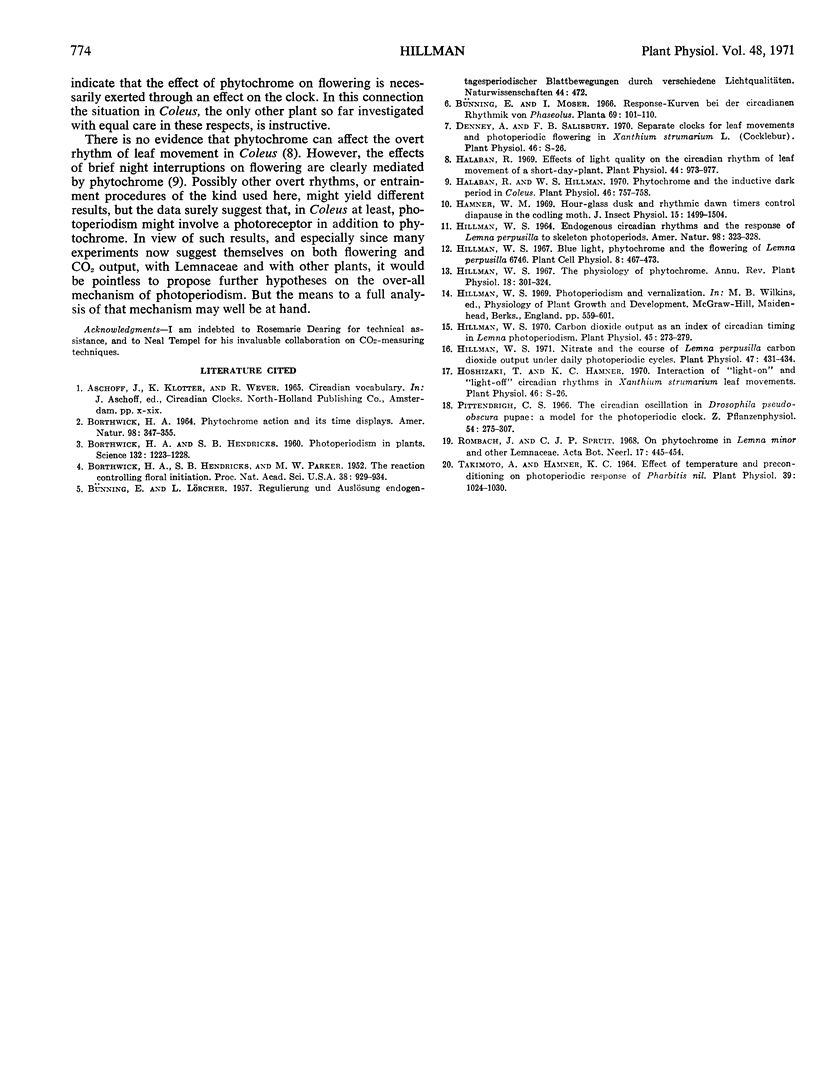Abstract
The entrainability of Lemna perpusilla CO2 output by periodic 15 minute red (R) and far red (F) illuminations was tested in low nitrate medium. R every 8 hour, symbolized R/R/R, gives a flat output (no entrainment) as does F/F/F. However, R/—/— (R every 24 hour) entrains rapidly, and F/—/— does so as well, in a similar manner. The effects of R/R/— and F/F/— also resemble each other closely. Entrainment by R/F/F or R/R/F is rapid and indifferent to order of presentation, e.g., R/F/F and F/R/F lead to the same steady state. Typical phytochrome reversals occur, e.g., R,F/F/F holds output flat, while F,R/F/F entrains in the manner of R/F/F. Blue (B) light acts like R in schedules such as B/F/F but like F in schedules such as B/R/R. In all schedules studied, the zeitgeber (primary synchronizer) appears to be the sharpest transition from a low to a high level of far red-absorbing phytochrome that occurs with a 24-hr periodicity. Thus in entrainment, and by inference in photoperiodic timing, the level of far red-absorbing phytochrome at any time may be less significant than the succession of levels of which it is a part, a conclusion that implies the existence of a “scanning” mechanism that compares levels of far red-absorbing phytochrome at various times of day.
Full text
PDF




Selected References
These references are in PubMed. This may not be the complete list of references from this article.
- Borthwick H. A., Hendricks S. B., Parker M. W. The Reaction Controlling Floral Initiation. Proc Natl Acad Sci U S A. 1952 Nov;38(11):929–934. doi: 10.1073/pnas.38.11.929. [DOI] [PMC free article] [PubMed] [Google Scholar]
- Borthwick H. A., Hendricks S. B. Photoperiodism in Plants. Science. 1960 Oct 28;132(3435):1223–1228. doi: 10.1126/science.132.3435.1223. [DOI] [PubMed] [Google Scholar]
- Halaban R. Effects of light quality on the circadian rhythm of leaf movement of a short-day-plant. Plant Physiol. 1969 Jul;44(7):973–977. doi: 10.1104/pp.44.7.973. [DOI] [PMC free article] [PubMed] [Google Scholar]
- Halaban R., Hillman W. S. Phytochrome and the inductive dark period in coleus. Plant Physiol. 1970 Nov;46(5):757–758. doi: 10.1104/pp.46.5.757. [DOI] [PMC free article] [PubMed] [Google Scholar]
- Hillman W. S. Carbon dioxide output as an index of circadian timing in Lemna photoperiodism. Plant Physiol. 1970 Mar;45(3):273–279. doi: 10.1104/pp.45.3.273. [DOI] [PMC free article] [PubMed] [Google Scholar]
- Hillman W. S. Nitrate and the Course of Lemna perpusilla Carbon Dioxide Output under Daily Photoperiodic Cycles. Plant Physiol. 1971 Mar;47(3):431–434. doi: 10.1104/pp.47.3.431. [DOI] [PMC free article] [PubMed] [Google Scholar]
- Takimoto A., Hamner K. C. Effect of Temperature and Preconditioning on Photoperiodic Response of Pharbitis nil. Plant Physiol. 1964 Nov;39(6):1024–1030. doi: 10.1104/pp.39.6.1024. [DOI] [PMC free article] [PubMed] [Google Scholar]


